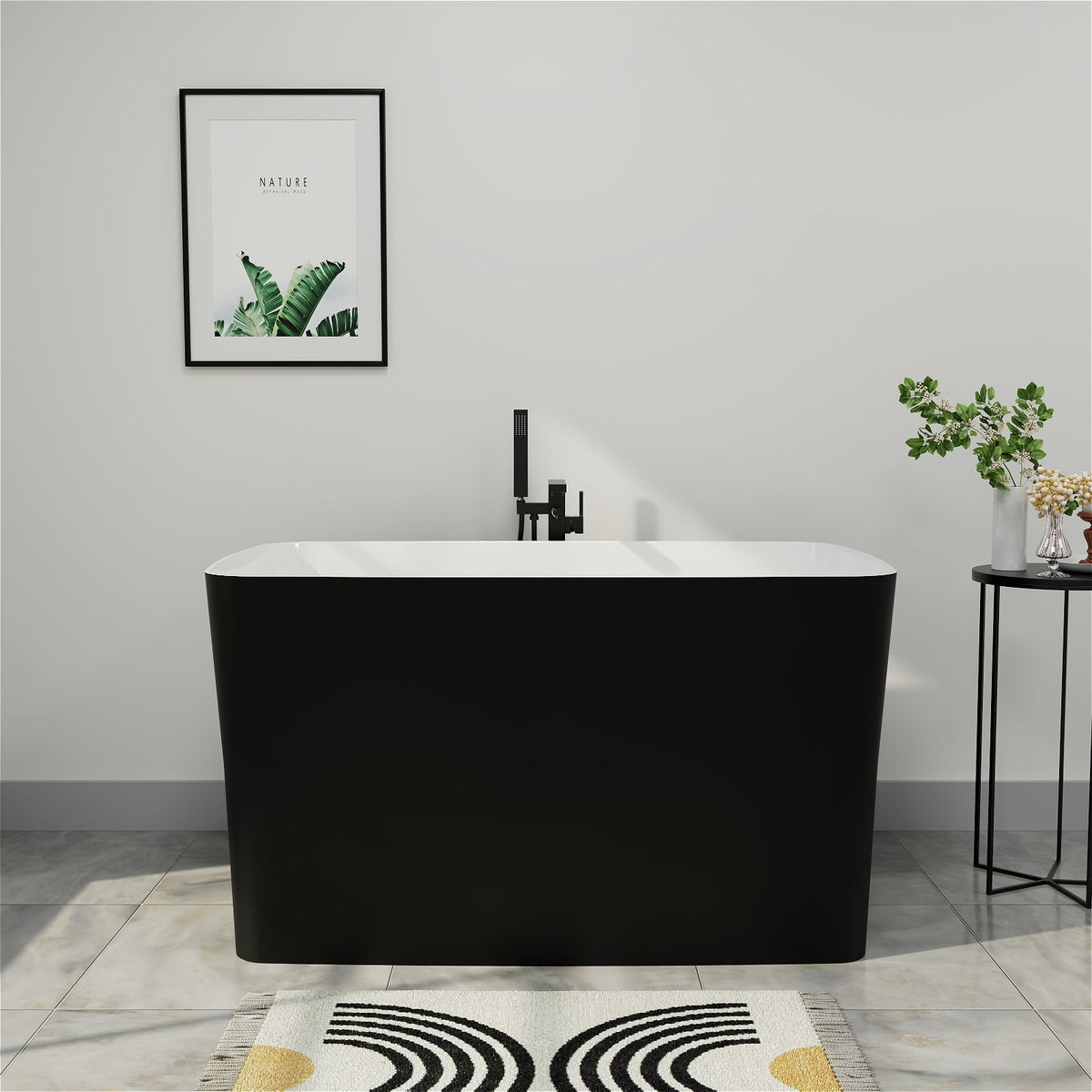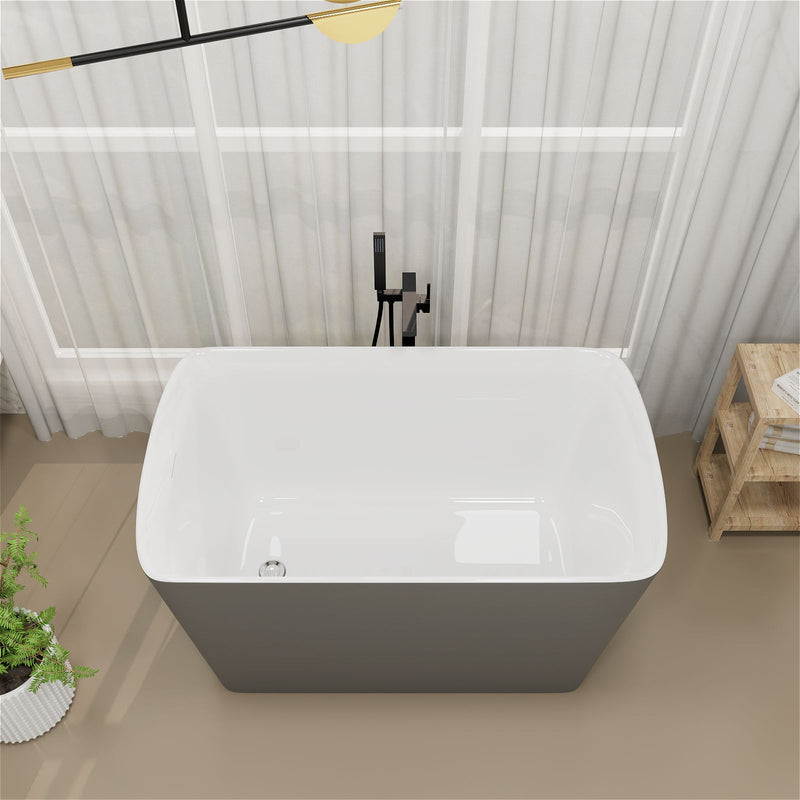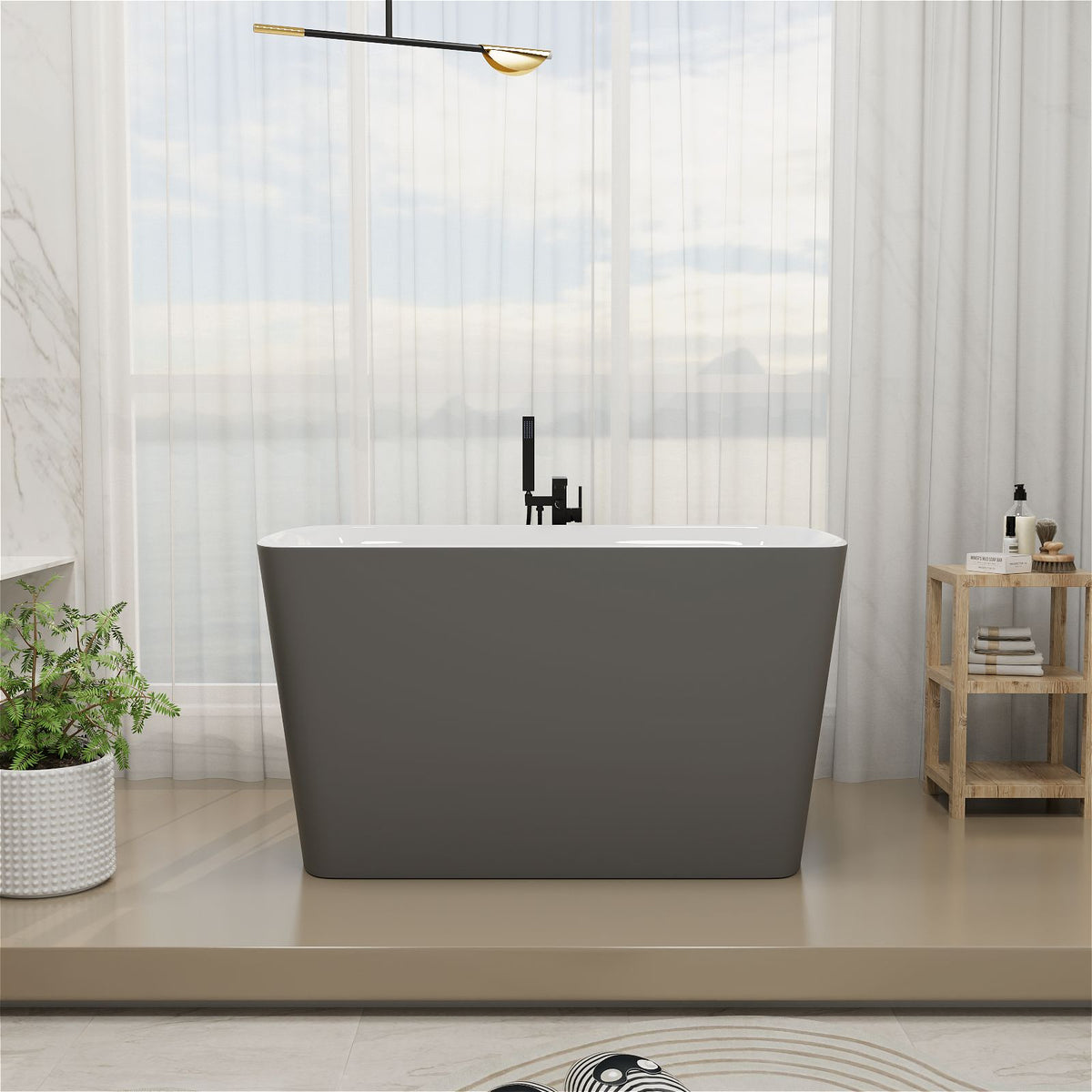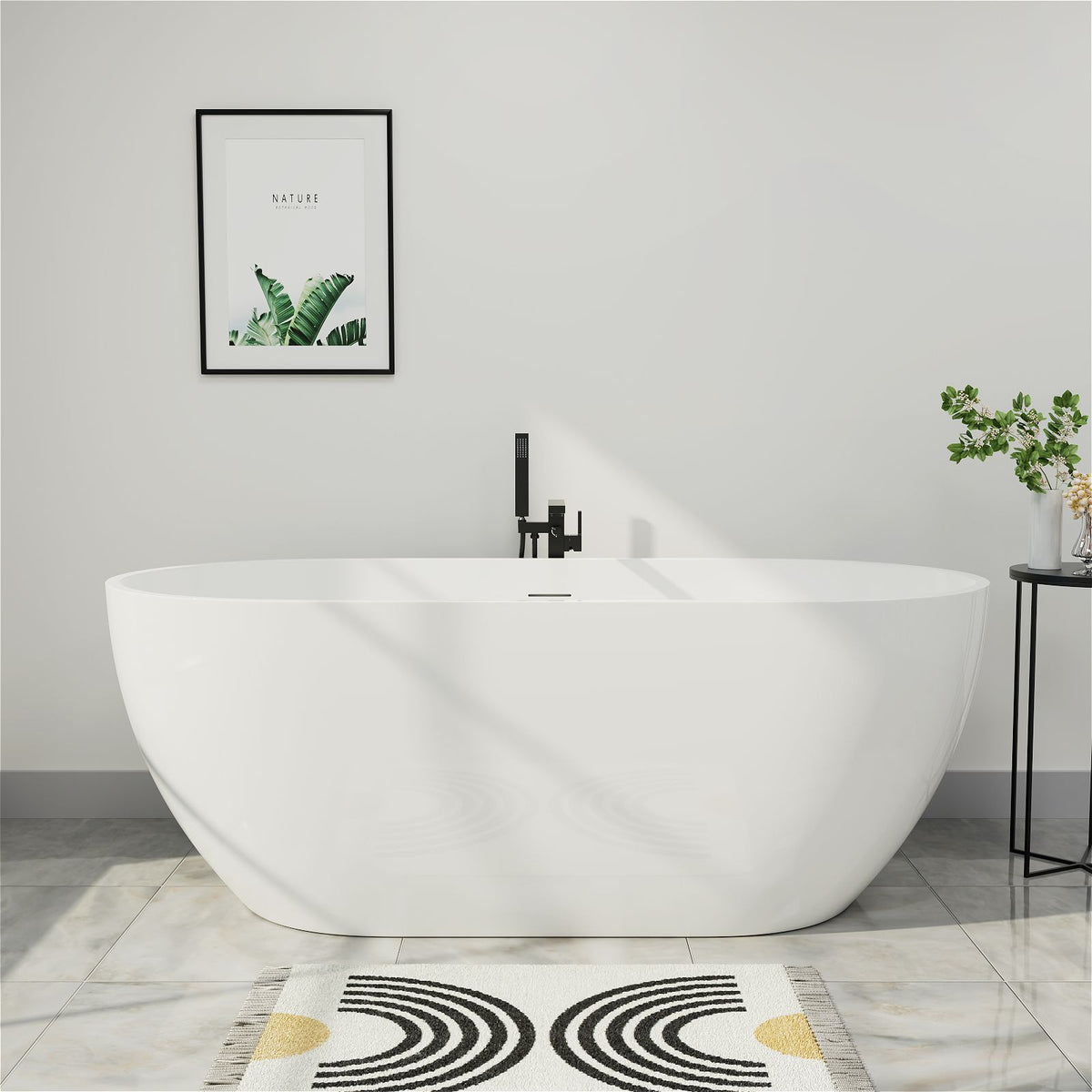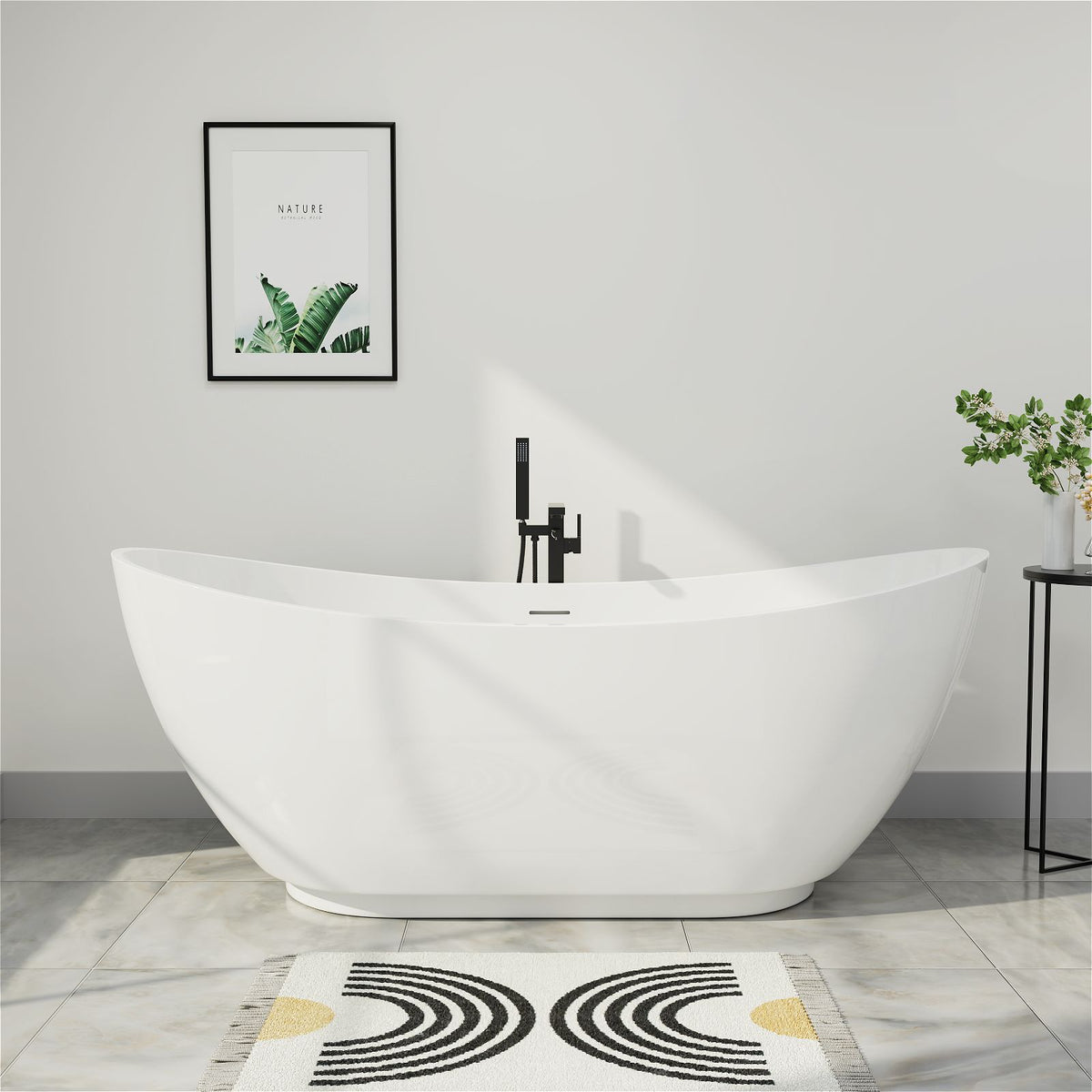Japanese soaking tubs, known as ofuro, represent a unique approach to bathing that transforms your daily routine into a profound relaxation experience. Unlike Western-style bathtubs designed for reclining, these compact yet deep tubs are crafted for upright, full-body immersion in a space-saving design. For homeowners with limited bathroom space but unlimited desire for luxury, a Japanese soaking tub offers the perfect solution, combining deep soaking capabilities with elegant aesthetics that enhance any bathroom decor.
Mokleba's collection of Japanese soaking tubs brings this centuries-old tradition to modern homes, featuring specially designed 47" x 27" tubs that maximize depth while minimizing footprint. Crafted from high-gloss acrylic with fiberglass reinforcement and available in versatile black, white, and gray color options, these freestanding tubs offer both the authentic ofuro experience and contemporary convenience. Whether you choose our model with a built-in seat or our classic deep-soak version, you're investing in a centerpiece that elevates your bathroom into a personal spa sanctuary.
The Unique Benefits of Japanese Soaking Tubs
Space Efficiency and Deep Immersion
The defining characteristic of authentic Japanese soaking tubs is their compact exterior dimensions coupled with exceptional depth. While standard Western tubs might measure 60-72 inches in length, Japanese tubs like Mokleba's 47-inch models prove that true soaking comfort doesn't require excessive space. These tubs prioritize vertical space over horizontal sprawl, allowing them to fit comfortably in even small bathrooms while providing the deep immersion that bathers crave. The intelligent design means you can enjoy a full-body soak in water that reaches shoulder-level without consuming your entire bathroom.
This space efficiency doesn't compromise comfort. The deep, upright soaking position offers therapeutic benefits that shallow reclining baths cannot match. The water pressure on your body increases with depth, providing gentle compression that can improve circulation and reduce muscle tension. The compact design also means less water is required to achieve full immersion, making these tubs an eco-friendlier choice for environmentally conscious homeowners who don't want to sacrifice luxury.
The Japanese Bathing Ritual and Modern Wellness
Traditional Japanese bathing is more than just getting clean—it's a meditative practice that honors relaxation and mindfulness. The ritual typically involves showering thoroughly before entering the tub, ensuring the bathwater remains pure and uncontaminated by soaps or shampoos. This practice allows the entire family to share the same bathwater, conserving both water and the energy required to heat it.
Once in the tub, the deep immersion creates a weightless sensation that relieves physical and mental stress. The water's buoyancy reduces the body's weight by approximately 90%, taking pressure off joints and muscles while the heat improves flexibility and promotes detoxification through sweating. Modern research has confirmed what Japanese culture has known for centuries: regular deep soaking can significantly reduce stress hormones, lower blood pressure, and improve sleep quality. By adopting a Japanese soaking tub, you're not just adding a fixture to your bathroom—you're incorporating a proven wellness practice into your lifestyle.
Key Considerations When Choosing Your Japanese Soaking Tub
With Seat vs. Without Seat: Finding Your Perfect Fit
Mokleba offers two design variations to accommodate different preferences and physical needs. Our built-in seat model provides a convenient perch that makes soaking more accessible, particularly for those with mobility challenges or who prefer the security of a designated sitting position. The seat allows you to maintain a comfortable upright position effortlessly, with the water level typically reaching chest-height when seated. This design closely mimics the traditional ofuro experience and is ideal for longer meditation sessions where supported posture enhances relaxation.
The seat-free model offers greater flexibility for movement and positioning during your soak. Without the built-in seat, bathers can customize their sitting or kneeling position and enjoy more legroom for stretching or subtle movements. This version is preferred by those who practice contrast hydrotherapy (alternating between hot and cold soaks) and appreciate the ability to shift positions easily. Both designs provide the same exceptional depth and quality construction—your choice ultimately depends on whether you value postural support or freedom of movement.
Material Advantages: Why Acrylic Enhances Your Soaking Experience
Mokleba's Japanese soaking tubs are crafted from high-gloss acrylic with fiberglass reinforcement, a material choice that offers distinct benefits for the ofuro experience. Unlike traditional materials like wood or steel, acrylic has natural insulating properties that keep water warm for extended periods. This exceptional heat retention means your bathwater maintains therapeutic temperatures throughout your soak without needing to add more hot water.
The non-porous surface of sanitary-grade acrylic feels pleasantly warm to the touch immediately upon contact and resists staining and bacterial growth. Unlike porous materials that require specialized cleaners and sealants, acrylic tubs are remarkably easy to maintain with just a soft cloth and mild, non-abrasive cleaners. The lightweight nature of acrylic compared to cast iron or stone makes installation simpler, particularly in upper-story bathrooms where weight may be a concern. Despite its lighter weight, the fiberglass reinforcement ensures surprising durability that stands up to decades of regular use when properly cared for.
Color Selection: Matching Your Bathroom Aesthetic
The choice between black, white, and gray allows you to select a tub that complements your existing bathroom decor or helps you create an entirely new aesthetic. Classic white offers a clean, timeless look that brightens smaller spaces and pairs beautifully with both traditional and contemporary design elements. The glossy white finish reflects light, creating an illusion of more space while projecting purity and simplicity.
Sophisticated gray provides a neutral, modern alternative that conceals water spots and mineral deposits better than white, potentially reducing cleaning frequency. Gray serves as an elegant bridge between light and dark bathroom color schemes. Dramatic black makes a bold statement that anchors the space and creates a striking contrast against light-colored walls or flooring. Black tubs particularly shine in minimalist bathrooms where they function as sculptural focal points.
Installation and Maintenance Guidelines
Planning Your Installation
As freestanding fixtures, Japanese soaking tubs offer flexible placement options within your bathroom. Unlike built-in tubs that must be positioned against walls, these tubs can be installed as true centerpieces, though they work equally well in corners or against walls. Proper installation begins with ensuring your floor is level to prevent stress on the tub structure and ensure proper drainage. While acrylic tubs are lighter than their cast iron counterparts, a professional should assess whether your floor requires additional support, particularly in older homes or upper-level bathrooms.
The freestanding design generally makes installation simpler than built-in models since no surrounding framework or tile work is required. However, plumbing considerations are crucial. You'll need to plan for both water supply lines and drainage, typically requiring a floor-mounted faucet and drain connection. Many homeowners choose to place their tub near existing plumbing to minimize installation costs. Always consult with a professional plumber to ensure all connections meet local building codes and function properly.
Care and Maintenance
Proper care will keep your acrylic Japanese soaking tub looking pristine for years. For routine cleaning, use a soft cloth or sponge with a mild, non-abrasive cleaner specifically formulated for acrylic surfaces. Avoid harsh chemicals, abrasive pads, or scrubbers that can scratch and dull the glossy finish. Rinse thoroughly with clean water after each use and wiping down the surface to prevent soap scum or hard water deposits from accumulating.
For stain removal, create a paste from baking soda and water, apply it to the affected area, and let it sit for 15-20 minutes before gently wiping away. Tough mineral deposits may respond to a diluted vinegar solution, but be sure to rinse thoroughly afterward. While high-quality acrylic resists UV damage, prolonged direct sunlight may cause slight discoloration over time—consider this when positioning your tub in sun-drenched bathrooms. With proper care, your Mokleba Japanese soaking tub will maintain its beauty and functionality as a long-term investment in your home wellness practice.
Transform Your Bathroom into a Personal Sanctuary
The Japanese soaking tub represents a perfect marriage of form and function—offering profound relaxation in a space-efficient design that elevates any bathroom's aesthetic. Whether you seek stress relief, muscle recovery, or simply a daily ritual of mindfulness, these tubs provide an authentic ofuro experience adapted for contemporary living.
Mokleba's collection of 47" x 27" Japanese soaking tubs brings this transformative wellness practice within reach, with thoughtful design variations to suit different preferences and elegant color options to complement any decor. Crafted from premium acrylic for durability and heat retention, these tubs represent an investment in both your home's value and your personal wellbeing.
Explore our collection today to discover how the deep, upright soaking tradition can enhance your daily routine and transform your perspective on what a home bathing experience can be.

